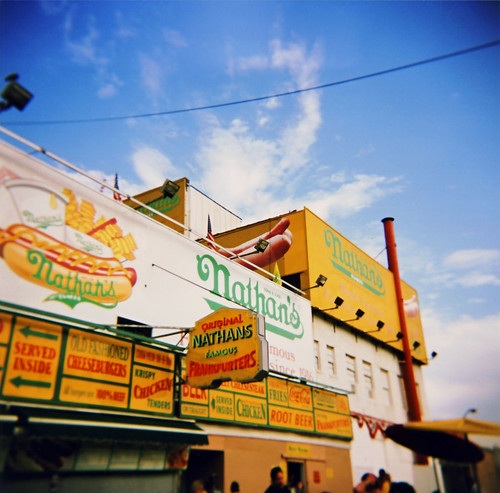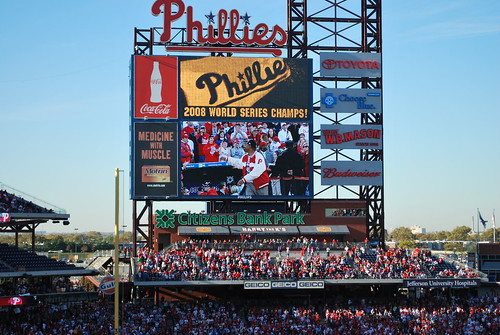I remembered this conversation as I rode the subway home from the Friday, August 14, 2009 Brooklyn Cyclones game. I have gone to at least one Cyclones game every one of their nine years. (Melvin and I and our former wives also saw the Queens Kings, a transitional team that played one year at St. John's University. The former St. Catherines (Ont.) Stompers were still the NYPL affiliate of the Blue Jays but the franchise had been bought by the Wilpon family, the owners of the Mets, in preparation for the move to Coney Island in 2001.) I have enjoyed many a Cyclones game but the realization I had on the train is I take the local team for granted. After all, I can go any time. One year, when I was not celebrating the date of my birth, a friend offered to take me out to the ball game. We got to KeySpan in the third inning and, when I noticed she was bored, we headed to the boardwalk in the seventh. I would never do that anywhere else. If I am seeing what will probably be my only Midland Rockhounds game, I am going to [make every effort to] get there on time, pay attention and stay until the end.
[Mel has pointed out that Midland wasn't the best example since we were in fact late to that game. But what are a couple guys to do? It was the first day of our 2008 Texas trip. The car rental clerk was painfully slow. We weren't going to drive five hours from Dallas to Midland with breakfast as our last meal. Joe Allen's Pit Bar-B-Que was worth being late to the game for.]

Prior to Friday's game, five of us went to Nathan's Famous. (Photo by dolbystereoben using a Holga 120 GN.) The original Coney Island store may be a New York institution but it's not mesquite smoked barbecue. To be honest, I'd even rather go to Tony Packo's despite my earlier criticisms. Like the Toledo restaurant, you don't go Nathan's for the food. In particular, stay away from the corn on the cob, which Nathan's renders inedible. The ladies had lobster rolls and pronounced them a bargain at six bucks. Nathan's is also the official hot dog at the stadium if the pre-game lines are too long.

Walking the two blocks from Nathan's to KeySpan, I couldn't help but to notice that Coney Island is still a dump. I mention this because when the stadium was built during the Giuliani administration, it was promised that the ball park would kick-off the revitalization of the neighborhood. Nine years later, that has not happened. Thor Equities, a development company headed by a native Brooklynite, bought much of the seaside property and proposed an amusement park veering towards Las Vegas. However, the company's desire to build apartment houses as part of the plan was poorly received. (KeySpan is located behind the green and purple mid-rises above; click on the image for the full rendering.) A counter-plan by the Bloomberg administration is currently undergoing land use review. Check back in another nine years.

This trip to the ball park was to celebrate the birthday--hey, different strokes for different folks--of Jose. Jose and I went on a short road trip last year, seeing the Delmarva Shorebirds, Potomac Nationals and Washington Nationals. But mostly I know Jose, and many of the other folks who went to the game, from my local watering hole. I never thought I'd frequent a bar "where everybody knows your name" but maybe it's just another baseball byway; Sam, the owner of Cheers (Ted Danson), was a former pitcher for the Red Sox. The Cyclones-Tigers game itself was entertaining. One team, but never both, scored in every inning but two. For the home team, it was about pitching. Starter Collin McHugh struck out seven in six innings, allowing only two runs. Matias Carrillo was perfect in the eighth inning and Michael Powers closed for his league-leading 12th save. Final score: Cyclones 6, Tigers 5.
MiLB Reports: Game Recap Box Score
On the subway ride home, in addition to having deep thoughts about my lack of loyalty to the Brooklyn Cyclones, I read the game program. On page 28, the team published the names and pictures of the 21 "Cyclones in the Majors." That averages out to not quite three players per year making it from short season, single-A ball to "the show." (That is consistent with the calculation I made when I saw the Pittsfield Mets in 1998, which celebrated the tenth anniversary of its affiliation with the big league team of the same name in similar fashion.) I did not recognize some of the players' names, something Melvin is far better at, so I did some research on the internet. When you scratch the surface, the photographs would have been more accurately titled, "Cyclones Who Played at Least a Few Games in the Majors." Perhaps a topic for a future post.
























